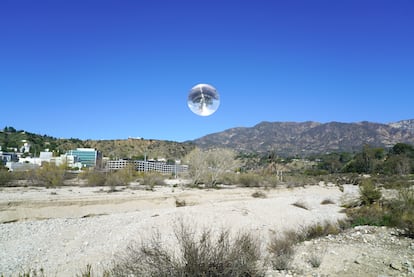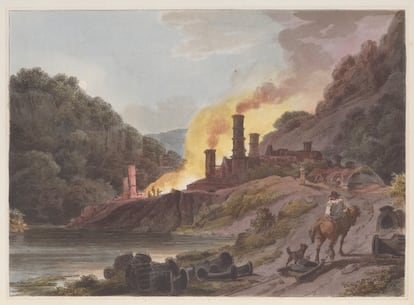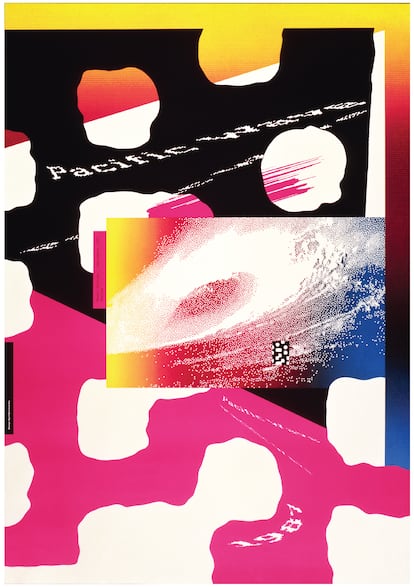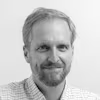Art collides with science in Los Angeles
Having become one of the great cultural events in California, PST ART advocates dialogue between both disciplines with an ecological message that resonates in a landscape scorched by fires

What time is it in Los Angeles? The city is raising its head from the rubble and struggling to regain normality in the endless devastated landscapes that we visited to write these lines just a few weeks before the wildfires. In a matter of days, like a disastrous optical illusion, they were turned to charred ruins. What is most disturbing is that some of the exhibitions of Pacific Standard Time, an ambitious artistic initiative of the Getty Foundation now renamed PST ART, seemed to predict disaster. In memory is an image of the exhibition Storm Cloud, at the Huntington Library in Los Angeles, which locates the origins of the current climate crisis in industrialization in 19th-century England.
A picture shows a view of Shropshire, an emblematic area of the industrial revolution and known for its key role in the development of the steel industry, with the incandescent glow of the furnaces in the background. It was not a fire, or perhaps it was. Did this nondescript vignette reflect the glow of industrial development or rather the first flash of an ignition in the heart of nature, back at the dawn of the Anthropocene? Days later, the image seemed to us almost identical to that of a helpless firefighter in the Palisades Hills, where the lack of rain and dry vegetation, factors induced by climate change, only aggravated the situation.

The initiative by the Getty Foundation, a generous patron that has given away $20 million to finance 84 exhibitions throughout Southern California, from San Diego to Palm Springs, follows a vague but pertinent thematic thread: the links between art and science, to which we can add the word ecology, a persistent subtext in most of the proposals. Taken together, they all seem to oppose the famous conference given by C. P. Snow in 1959 on “the two cultures,” which defined artistic and scientific language as two hostile and irreconcilable realms. PST ART, on the contrary, maintains that they have cooperated for centuries, in a synthesis that invalidates any hypothesis of schism. In the historic library of Caltech, the Nobel Prize-winning university located in Pasadena, a city affected by the Eaton fire, a pioneer of the Light and Space movement like 91-year-old Helen Pashgian, exhibits a sphere in which the infinity of the cosmos seems to be observed, just like the shell that contains the sound of the ocean.
All around, various objects and documents show that this intersection of disciplines is not new, far from it. Galileo Galilei created artistic fictions to represent space, such as his expressive cracks on the surface of the Moon, and certain botanical drawings can be considered works of art. Space telescopes such as Hubble and Webb capture images in wavelengths that go beyond the spectrum visible to the human eye. In translating this data, NASA scientists act as colorists: they apply chromatic processing so that we can see something. Molecular structure is understood thanks to 3D models made by anonymous people, not unlike Dadaist sculptures. And a lunar landscape appears juxtaposed with Death Valley in a work by Stephen Nowlin, in a representation that distills the same essence of the American landscape that photographers immortalized at the beginning of the 20th century.
Several miles south, the Natural History Museum is opening a new diorama hall that had been closed for 30 years. The renovation seeks to correct the scientific inaccuracies of these representations of the natural world, so emblematic of American museums. Three of them have been commissioned from contemporary artists. The one by Lauren Schoth reflects the Los Angeles riverbed was filled with concrete to control flooding. The transformation, conceived as an engineering solution, ended up turning the river into an artificial artery, and an emblem of the extreme urban development of the Californian landscape. Meanwhile, the Academy Museum reminds us that the city’s greatest invention, the Hollywood industry, also involved this inevitable alliance between art and science, as demonstrated by an exhibition dedicated to the invention of color film. Historical exhibitions abound on the program. For example, at the Getty Museum itself, the Lumen exhibition recalls the fascination with the starry sky that has existed since the Middle Ages, as evidenced by an impressive collection of astrolabes and contemporary installations by Anish Kapoor, which also seem to link light and divinity.

On the recent art front, Beatriz da Costa’s exhibition at the Municipal Gallery in Los Angeles recalls her performances in which pigeons equipped with sensors collected data on air pollution, a brilliant example of art confused with activism (or was it the other way around?). At the MOCA, Olafur Eliasson brings together 26 new works that rethink old ideas about light, color and geometry, in which the principles of physics and optics are put at the service of a sensorial experience with political implications. At the Hammer, the exhibition Breath(e) brings together artists and collectives with a common militant impulse: from the photographs of LaToya Ruby Frazier, which document the water crisis in Michigan, to the collective ikkibawiKrrr, which addresses the life of the haenyeo, divers from the Korean island of Jeju who collect algae using an ancestral breathing technique.
The most ominous work, however, may be an installation by David Bowen, created with NASA’s Astrobiology Laboratory: a field of mechanized reeds that sway in real time to the rhythm dictated by the winds of Mars, as furious as those of California. All of which sends out an ominous omen: that of an ecosystem doomed to resemble that of the neighboring planet, where carbon dioxide, extreme temperatures and dust storms have smothered any trace of flora and fauna.
‘PST ART. Art & Science Collide’. Los Angeles. Until March 1.
Sign up for our weekly newsletter to get more English-language news coverage from EL PAÍS USA Edition
Tu suscripción se está usando en otro dispositivo
¿Quieres añadir otro usuario a tu suscripción?
Si continúas leyendo en este dispositivo, no se podrá leer en el otro.
FlechaTu suscripción se está usando en otro dispositivo y solo puedes acceder a EL PAÍS desde un dispositivo a la vez.
Si quieres compartir tu cuenta, cambia tu suscripción a la modalidad Premium, así podrás añadir otro usuario. Cada uno accederá con su propia cuenta de email, lo que os permitirá personalizar vuestra experiencia en EL PAÍS.
¿Tienes una suscripción de empresa? Accede aquí para contratar más cuentas.
En el caso de no saber quién está usando tu cuenta, te recomendamos cambiar tu contraseña aquí.
Si decides continuar compartiendo tu cuenta, este mensaje se mostrará en tu dispositivo y en el de la otra persona que está usando tu cuenta de forma indefinida, afectando a tu experiencia de lectura. Puedes consultar aquí los términos y condiciones de la suscripción digital.
More information
Archived In
Últimas noticias
The story of the Málaga virus: The code that haunted Google’s cybersecurity center director for 30 years
The impact of Ecuador’s mega-prison: A polluted river, cleared forests and military checkpoints
Corinne Low: ‘I’m more concerned about the female happiness gap than the gender wage gap’
Trump traveled on Epstein’s plane ‘many more times’ than previously thought, according to new documents
Most viewed
- The low-cost creative revolution: How technology is making art accessible to everyone
- Christian Louboutin: ‘Young people don’t want to be like their parents. And if their parents wear sneakers, they’re going to look for something else’
- All the effects of gentrification in one corner of Mexico’s Colonia Roma
- Liset Menéndez de la Prida, neuroscientist: ‘It’s not normal to constantly seek pleasure; it’s important to be bored, to be calm’
- Christmas loses its festive spirit: ICE fears cast shadow over religious celebrations











































